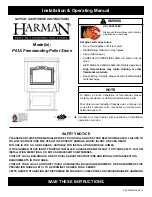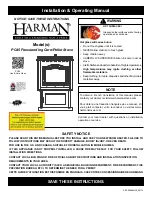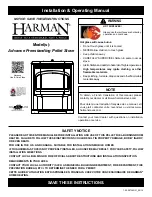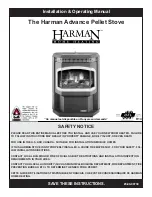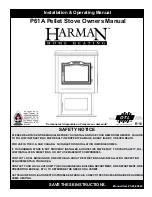
CLEO COMBI
.
8192000 Rev.08 – EN
23
5.
FLUE
Fundamental requisites for correct functioning of the appliance:
•
the internal section must be preferably circular;
•
it must be heat insulated and impermeable and built with
materials suitable to resist heat, combustion products and
any condensate.
•
It must be without bottlenecking and have a vertical trend
with branches not exceeding 45°.
•
if already used, it must be clean;
•
respect the technical data in the instructions manual;
Whenever the flues have a square or rectangular section the
internal edges must be rounded with a radius that is no less
than 20 mm. For the rectangular section, the maximum ratio
between the sides must be
≤
1.5.
A section that is too small causes the draught to decrease. A
minimum height of 4 m is recommended.
They are prohibited
and therefore jeopardise the good
functioning of the appliance: asbestos cement, galvanised
steel, rough and porous internal surfaces. In Picture 3 find
some solution examples.
The minimum section must be 4 cm
2
(e.g. 20x20cm) for
appliances whose pipe diameter is less than 200mm, or
6.25cm
2
(e.g. 25x25cm) for appliances with diameter
exceeding 200mm.
The draught created by your flue must be sufficient but not
excessive.
A section of the flue that is tool large can have a volume that is too big to heat and therefore cause functioning
difficulties of the appliance; to prevent this; duct the same along its entire length. A section that is too small causes
the draught to decrease.
The flue must be suitably distanced from inflammable or combustible materials by appropriate insulation or
air gap.
It is prohibited to allow system pipes or air intake ducts to transit inside the same. It is also prohibited to make mobile
or fixed apertures on the same for the connection of further different devices.
6.
CONNECTION TO THE FLUE
The appliances with automatic door closure (type 1) must function, for safety reasons, with the hearth door closed
(except for the fuel feeding phase or removal of ash).
The appliances with doors that do not close automatically (type 2) must be connected to its own flue. Functioning is
NOT allowed with the door open.
The connection pipe to the flue must be as short as possible, straight, sealed and in compliance with Standards in
force. Assembly of the PROTECTION see Chapt. 20.
The connection must be made with stable, strong pipes (we recommend a thickness of 2 mm) and be fixed
hermetically to the flue. The internal diameter of the connection pipe must correspond to the external diameter of the
stove combustion gas discharge stub pipe ( DIN 1298 ).
ATTENTION
: whenever the connection passes through particulars made up from inflammable materials within the
radius of 20 cm around the pipe, all inflammable materials must be replaced by fire-proof materials that
are also resistant to heat.
For good functioning of the appliance, it is essential that the place of installation has sufficient air for combustion (see
paragraph 10).
The depression at the chimney must be 12 Pa (= 1.2 mm of water column).
The measurement must always be taken with the machine hot (nominal calorific yield). When the depression exceeds
20 Pa (2.0 mm water column) the same must be reduced with the installation of an additional draught regulator
(butterfly valve) on the exhaust pipe or in the chimney.
For safety reasons, the hearth door can only be opened when feeding the fuel (wood). The hearth must remain closed
during functioning and standstill periods.
Picture 3
(1) AISI 316 steel flue with double chamber
insulated with material resistant to 400°C.
Efficiency 100% excellent.
(2) Flue in refractory material with double
chamber, insulated and covered externally in
lightened
concrete.
Efficiency
100%
excellent.
(3) Traditional flue in clay with square section and
gaps.
Efficiency 80% excellent.
(4) Avoid flues with rectangular section, inside
which the ratio is different to the diagram.
Efficiency 40% poor
.
A+1/2
A
Max.
A+1/2A
(3)
(1)
(2)
(4)
































